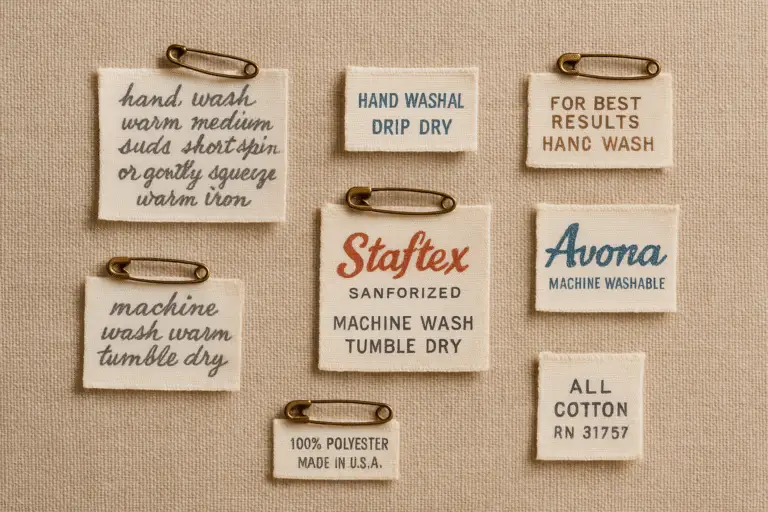Fabric tags are one of the easiest ways to determine the era of vintage clothing. They reveal details like fiber content, care instructions, and even manufacturing methods. Here’s what you need to know:
- Pre-1960s: Tags were simple, often hand-sewn, and made from natural materials like cotton or silk. Care instructions were rare.
- 1960s-1970s: Regulatory changes required fiber content on tags. Synthetic fabrics like polyester became popular, and printed satin labels replaced woven tags.
- 1980s Onward: Care labels became mandatory, with international symbols and smaller, machine-made tags becoming the norm.
Key clues include the material of the tag, the font style, and the presence (or absence) of care instructions. For garments without tags, details like zippers, buttons, and stitching can help identify their age. Understanding these elements ensures you can better evaluate vintage clothing.
Is It VINTAGE? Clothing Tags and Labels
Key Features of Vintage Fabric Tags
Fabric tags hold valuable clues when it comes to identifying the age of vintage clothing. The materials used for these tags can provide significant insight into the time period a garment was made. Let’s take a closer look at how different materials, ranging from paper to woven or embroidered fabrics, help pinpoint production eras.
Materials and Construction
The type of material used for fabric tags has evolved over the decades, making it a helpful indicator of a garment’s age. For example, paper tags became more prevalent in the 1990s and early 2000s. While they occasionally appear on older garments, these tags often show signs of aging, such as yellowing or becoming brittle.
On the other hand, woven tags with fully integrated care instructions and embroidered labels with visible threading are hallmarks of earlier production periods. The presence of embroidered labels, particularly those with threading visible on the back, is a strong indicator of authenticity tied to a specific era. In contrast, many modern reproductions opt for printed labels, which are applied directly onto the fabric or tag. These printed labels tend to have a flatter, more uniform look compared to their vintage counterparts.
Understanding these material differences lays the groundwork for exploring other aspects of vintage tags, such as design, placement, and regulatory markings.
Step-by-Step Guide to Dating Vintage Clothing by Fabric Tags
Building on the material differences discussed earlier, here’s how you can date vintage clothing by analyzing fabric tags. This methodical approach will help you estimate the age of any vintage garment with greater accuracy.
Check Fabric Composition
The materials listed on fabric tags can be a strong indicator of when a garment was made, as different fibers gained popularity at specific times.
Pre-1960s clothing was primarily made from natural fibers. According to Ian Drummond Vintage:
“Clothing was mostly made from natural fabrics like cotton, linen, silk and wool before the 1960s, with the exception of rayon and nylon, which were used for dresses, blouses, ties and stockings from the 20s/30s onwards as an alternative to silk.”
Rayon and nylon, introduced in the 1920s and 1930s, are common in mid-century garments.
The 1970s ushered in a wave of synthetic fibers. As Ian Drummond Vintage notes, “Synthetics exploded in the 1970s and have continued to dominate since then.” Polyester, in particular, became a defining fabric of the decade:
“It seems polyester was used for almost everything in that decade, but early polyester is often much thicker and coarser than modern polyester.”
Pay attention to brand names on tags for additional clues. Names like Lycra (spandex), Qiana nylon (1968–mid-1970s), Orlon or Zeran (acrylic), and Dacron or Vycron (polyester) can help pinpoint specific timeframes.
Metallic fibers can also provide hints. Lamé fabrics, including Lurex with fine metallic threads, were especially popular during the 1960s and 1970s.
Once you’ve identified the fabric, move on to the care instructions for further context.
Look for Care Instructions
Care labels or their absence can offer additional dating clues. Detailed fiber content labels generally indicate garments made in the 1970s or later. Tuppence Ha’penny Vintage notes:
“A label with fibre content details almost always indicates 1970s or later.”
The language used on tags can also help. For example, Tuppence Ha’penny Vintage explains:
“Polyester wasn’t invented until the 1950s, and was labelled under trade names like Dacron and Terylene until at least the 60s. So, anything labelled polyester is generally post 70s…”
Logos like the Woolmark can also narrow down production dates. The Woolmark certification was introduced in 1964, with the Woolmark blend logo appearing in 1971 and the wool blend logo debuting in 1999.
Finally, examine the design of the tag itself to complete your analysis.
Compare Tag Design
The design of fabric tags can reveal a lot about when a garment was made. Fonts, label construction, and overall aesthetics evolved significantly over the decades.
Font styles changed over time. Blair Carpenter from Shine Daily explains:
“Early labels are pretty much all in script fonts. In the 1960s brands started to transition away from fancy script fonts to simpler ones. By the 1980s most labels used sans serif fonts.”
Label construction also shifted. Early and mid-20th century tags were often woven, while printed satin labels became more common starting in the 1960s. Vintage labels also tended to be larger, with bold typefaces on collar or waistband tags.
Some vintage tags feature logos or graphics that are no longer used, providing another clue to the garment’s age. To confirm your findings, refer to trusted resources like the Vintage Fashion Guild’s label database, which catalogs tag designs, logos, and fonts from different eras.
Be cautious with factory production tags. These generic tags, often printed with standard fonts, were mass-produced and used over long periods, making them less reliable for precise dating.
Fabric Tag Characteristics by Decade
When it comes to dating vintage garments, understanding how fabric tags evolved over the decades is a game-changer. Each era had its own materials, designs, and labeling practices, offering valuable clues about a garment’s history.
1940s–1950s
During the 1940s and 1950s, fabric tags were all about showcasing craftsmanship and natural materials. Woven labels were the norm, featuring intricate script fonts and detailed brand information sewn directly into the garment. These tags exuded quality, reflecting the era’s focus on natural fibers like cotton, wool, silk, and linen. Unlike modern tags, they didn’t include fiber percentages, as such details weren’t required at the time. Rayon also emerged as a popular alternative to silk for dresses and blouses.
Union labels were a key feature of this period, especially on American-made clothing. Labels from groups like the International Ladies’ Garment Workers’ Union (ILGWU) and the Amalgamated Clothing Workers of America signified domestic production and adherence to union standards.
Another hallmark of this era was the craftsmanship of the tags themselves. Tags were hand-sewn and made from cotton or silk ribbon, staying true to the natural fiber preference of the time.
By the 1960s and 1970s, new materials and regulations began reshaping the way fabric tags were made and what they included.
1960s–1970s
The 1960s and 1970s brought major changes, starting with the Textile Fiber Products Identification Act of 1960, which required manufacturers to disclose fiber content percentages. This marked the beginning of a new era in garment labeling.
Synthetic fibers became increasingly common, with materials like polyester (marketed under names like Dacron and Terylene), acrylic (Orlon and Zeran), and spandex (Lycra) gaining popularity. These new fabrics required specific care instructions, prompting manufacturers to update their tags.
Printed satin labels began replacing woven tags during this time. These were more cost-effective and allowed for detailed care instructions, reflecting the minimalist design trends of the era. Care symbols also started appearing on tags, guiding consumers on proper washing and drying methods for synthetic fabrics and blended textiles.
Another key development was the introduction of the Woolmark logo in 1964, which helped shoppers identify genuine wool products. This period also saw the rise of permanent press treatments and fabric blends, making clear care instructions even more essential.
1980s and Beyond
The 1980s ushered in a new level of standardization for fabric tags. Thanks to the Federal Trade Commission’s Care Labeling Rule, care instructions became mandatory on all textile products sold in the United States. This ensured that consumers had clear guidance on how to maintain their garments.
Polyester blends became the go-to fabric choice, often mixed with cotton or wool. Tags from this period typically included precise fiber percentages, such as “65% Polyester, 35% Cotton”, aligning with regulatory requirements.
Design trends shifted as well. Sans serif fonts replaced ornate scripts, offering a cleaner, more modern look. International care symbols became standardized, making it easier for manufacturers to sell garments globally without worrying about language barriers.
By this time, computer-generated labels had replaced hand-sewn tags, allowing for greater consistency and more detailed information. Tags also became smaller and more focused on functionality, prioritizing clarity over decorative elements.
Lastly, country of origin labeling became more prominent as production moved overseas. Tags from the 1980s onward often included “Made in” information, reflecting the growing globalization of the fashion industry.
Tips for Authenticating and Avoiding Mistakes
Authenticating vintage clothing goes beyond just reading tags. It requires a keen eye for detail and a good understanding of common mistakes. Even seasoned collectors can fall for reproduction tags or misdate garments, which can impact their value and authenticity.
Spotting Fake and Altered Tags
Modern reproductions often give themselves away with historical inaccuracies. For example, a tag claiming to be from the 1950s but listing fiber percentages is a red flag. Why? The Textile Fiber Products Identification Act didn’t come into effect until 1960. Similarly, care symbols on tags supposedly from the 1940s are another warning sign, as these symbols weren’t standardized until the late 1960s.
Pay attention to font styles and materials. Authentic tags from the 1940s and 1950s often featured elegant script or decorative fonts. Reproduction tags, on the other hand, frequently use modern sans serif fonts that didn’t become popular until the 1980s. The materials used for tags also matter – vintage tags were typically made with tightly woven cotton or silk threads, while reproductions often rely on synthetic materials with looser weaves.
ILGWU labels can provide critical clues. Authentic International Ladies’ Garment Workers’ Union (ILGWU) labels from the 1940s-1960s had distinct designs, colors, and numbering systems that changed over time. Reproduction labels often miss these details, using incorrect fonts, colors, or numbering that doesn’t align with the era they claim to represent.
Tag placement and attachment methods are equally important. Vintage tags were usually hand-sewn with cotton thread, whereas modern reproductions often use synthetic threads or machine stitching that looks too perfect. Additionally, authentic vintage tags typically show natural wear from age. If a tag looks pristine on a garment that’s supposedly decades old, it’s worth questioning its authenticity.
When tags are missing, the garment’s construction becomes the next best way to determine its age.
Dating Methods When Tags Are Missing
If a garment lacks fabric tags or the tags are unreliable, construction details can help pinpoint its era.
Construction techniques can reveal a lot. For example, hand-finished seams, French seams, and bound buttonholes were common in the 1940s and 1950s when high-quality craftsmanship was the norm. By the 1960s, mass production led to simpler finishing techniques like machine-serged edges.
Zippers and buttons are excellent time markers. Metal Talon zippers were widely used from the 1930s to the 1950s, while nylon zippers didn’t appear until the late 1950s. Crown zippers were popular in the 1940s-1960s, and YKK zippers became dominant starting in the 1960s. The type of zipper pull, teeth material, and tape color can all offer dating clues. Similarly, buttons made of natural materials like mother-of-pearl, wood, or metal were common before the 1960s, when plastic buttons became standard.
Lining fabrics and their construction also tell a story. In the 1940s and 1950s, acetate linings were popular and often matched the outer fabric. By the 1960s and 1970s, polyester linings became the norm, usually in neutral colors like white or beige. The way the lining is attached and its condition compared to the rest of the garment can provide additional insights.
Shoulder pads can pinpoint specific decades. Thick, structured shoulder pads from the 1940s were typically made with cotton batting and covered in muslin. In contrast, the softer, foam-based shoulder pads of the 1980s were often removable and attached with Velcro – a feature not available in earlier decades.
Hems and their finishing techniques evolved over time. Hand-rolled hems were standard for high-quality garments through the 1950s. By the 1960s, machine-rolled hems became more common. The type of thread used, stitch length, and overall finishing method can all help date a garment accurately.
Conclusion
Fabric tags are a dependable clue when determining a garment’s era. The fabric composition, care instructions, and tag design offer valuable hints about its origins. Changes in manufacturing and labeling practices over time can help narrow down its history even further.
If tags are missing or seem questionable, construction details like zipper styles, buttons, and sewing techniques can serve as additional tools to verify a piece’s authenticity. These details work hand-in-hand with tag analysis to help avoid costly mistakes when identifying vintage clothing.
The more you practice, the sharper your eye becomes at spotting inconsistencies and identifying period-specific details. Starting with well-documented pieces is a great way to build confidence and expertise. Over time, this hands-on experience can deepen your understanding of vintage fashion.
Whether you’re curating a personal collection or running a vintage clothing business, mastering fabric tag analysis is a powerful skill. Paired with an understanding of construction details and historical context, it ensures the authenticity and value of your vintage finds remain intact.
FAQs
How can I tell if a fabric tag is genuinely vintage or a modern reproduction?
To figure out if a fabric tag is truly vintage, focus on its material, craftsmanship, and overall look. Genuine vintage tags were often created using natural materials like cotton or linen and might feature embroidered or woven details. These tags usually reflect the production methods of their era, often showing signs of aging, such as fading, wear, or retro-style fonts and designs.
On the other hand, modern reproductions tend to have printed tags made from synthetic materials. They might appear too pristine or intentionally aged to look old. Some even include branding or logos that mimic vintage aesthetics but lack the authentic workmanship found in original vintage items. Paying attention to these details can help you spot the real thing!
What mistakes should I avoid when using fabric tags to date vintage clothing?
When using fabric tags to date vintage clothing, it’s important not to rely solely on brand labels. Many modern brands recreate vintage-inspired designs or produce reproductions, which can easily lead to confusion. Another frequent pitfall is misjudging fabric types. Take the time to research and verify fabric content, as newer materials can sometimes imitate the look and feel of older ones.
Pay close attention to details like stitching, zippers, and the garment’s overall construction. These features often hold valuable clues that can either support or challenge the date indicated by the fabric tag.
How can I figure out the age of a vintage garment without readable fabric tags?
If the fabric tags are missing or too worn to read, you can still figure out the age of a vintage garment by looking closely at other details. Start with the fabric itself – different materials were trendy during specific decades. For instance, polyester became a go-to fabric in the 1970s, while rayon was more commonly used in the 1930s and 1940s.
Next, check out the construction details like zippers, buttons, and stitching. Metal zippers were the norm before the 1960s, with plastic versions becoming more prevalent afterward. The stitching style and even the type of thread used can also give you hints about the garment’s age. Don’t overlook the linings or any unique design elements – they can be great clues for pinning down the time period.
For those who want to dig deeper, a burn test can help identify the fabric content, offering another piece of the puzzle when dating vintage clothing. While it takes time and practice to spot these details, honing this skill is incredibly useful for anyone passionate about vintage fashion.



